Salby M.L. Fundamentals of Atmospheric Physics
Подождите немного. Документ загружается.

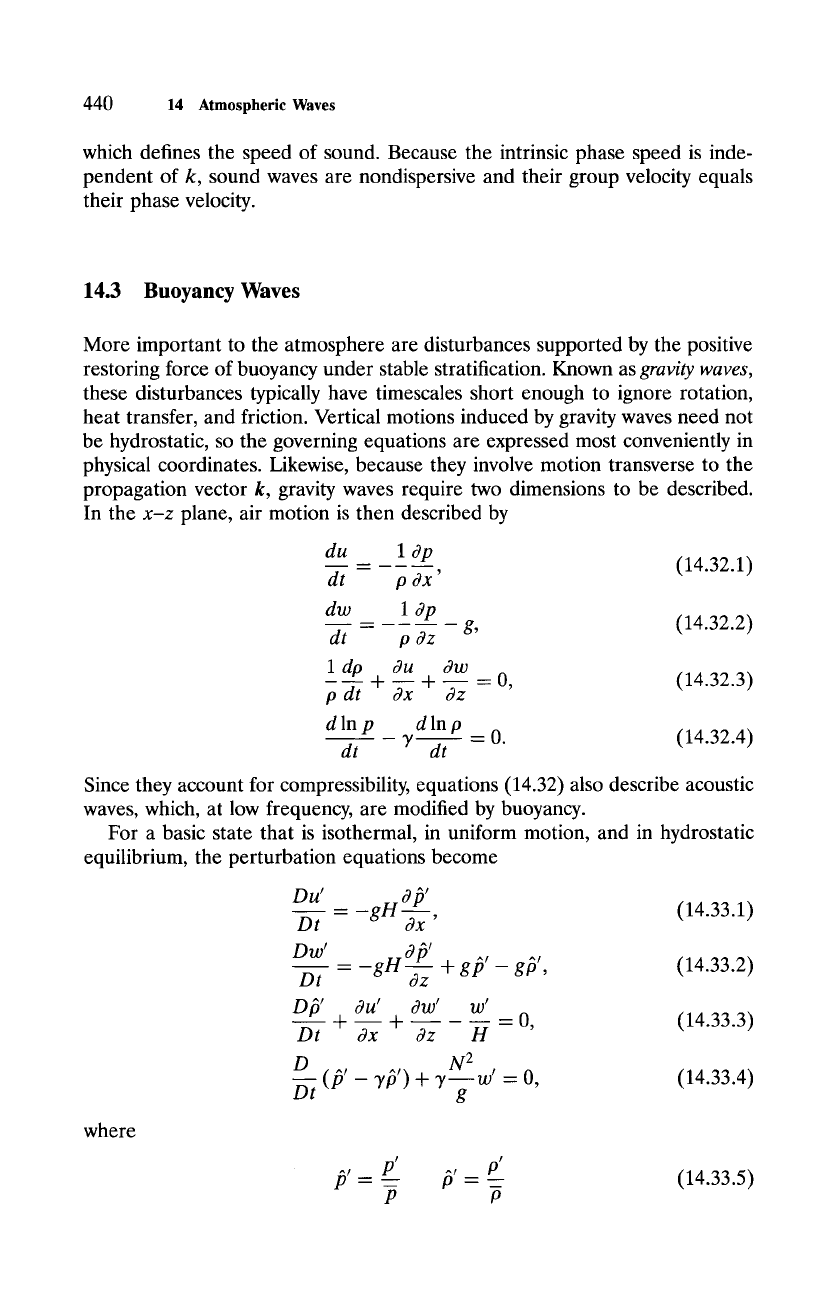
440 14 Atmospheric Waves
which defines the speed of sound. Because the intrinsic phase speed is inde-
pendent of k, sound waves are nondispersive and their group velocity equals
their phase velocity.
14.3 Buoyancy Waves
More important to the atmosphere are disturbances supported by the positive
restoring force of buoyancy under stable stratification. Known as
gravity waves,
these disturbances typically have timescales short enough to ignore rotation,
heat transfer, and friction. Vertical motions induced by gravity waves need not
be hydrostatic, so the governing equations are expressed most conveniently in
physical coordinates. Likewise, because they involve motion transverse to the
propagation vector k, gravity waves require two dimensions to be described.
In the
x-z
plane, air motion is then described by
du 10p
dt p Ox '
dw 1 ~p
dt p dz
(14.32.1)
g, (14.32.2)
1 do du
3w
...... 0, (14.32.3)
p d t F --~x -~ d z
d In p d In p
= 0. (14.32.4)
dt 3/ dt
Since they account for compressibility, equations (14.32) also describe acoustic
waves, which, at low frequency, are modified by buoyancy.
For a basic state that is isothermal, in uniform motion, and in hydrostatic
equilibrium, the perturbation equations become
DN ! ^~_~p'
- -gH
(14.33.1)
Dt ax '
Dw' -gH ~'
Dt - ~ + gP' - g~''
(14.33.2)
D f/ Ou' Ow' w'
D----i--t- ~ -~ O z
H = 0, (14.33.3)
D N 2
-- (p' - + = o,
Dt g
(14.33.4)
where
^, p' ^, p'
p - --_ p = --_ (14.33.5)
P O
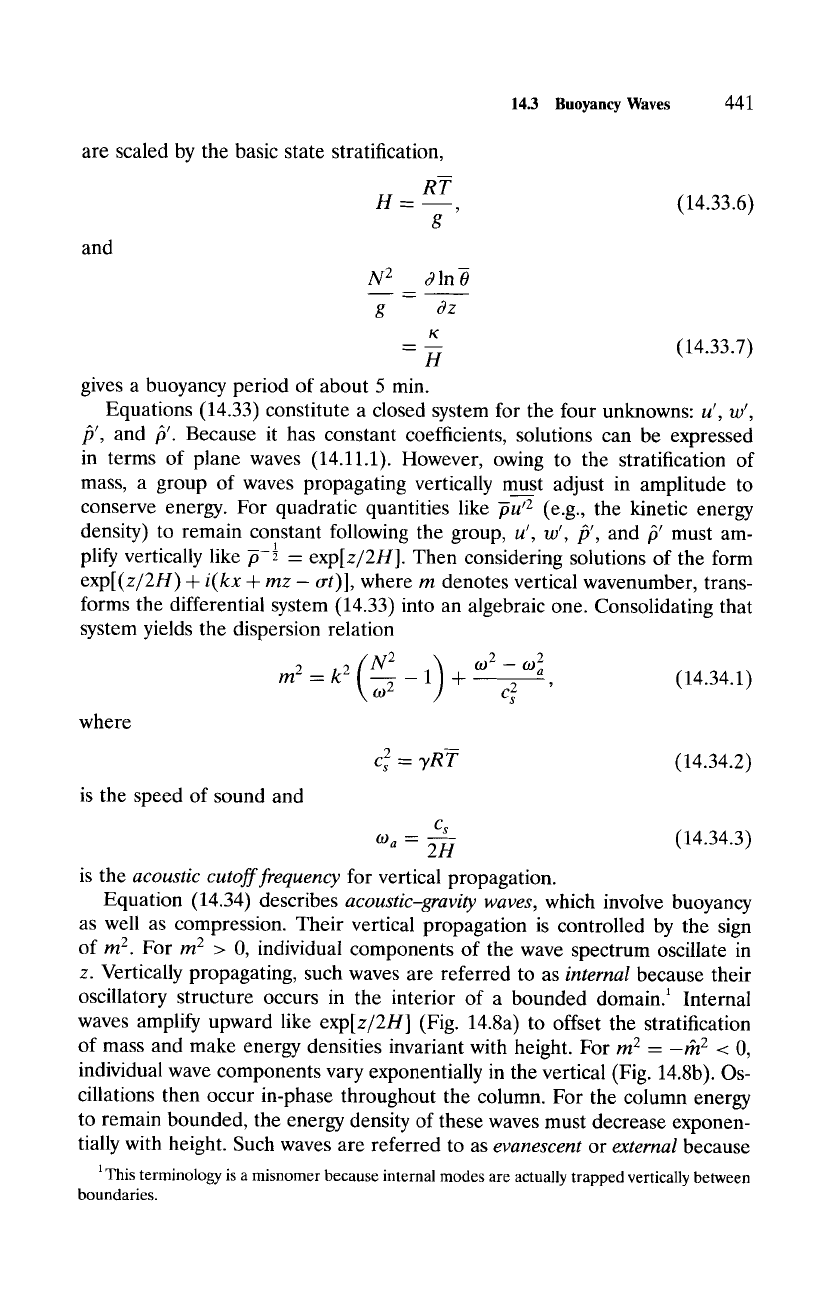
14.3 Buoyancy Waves
441
are scaled by the basic state stratification,
RT
H=
g
and
(14.33.6)
is the speed of sound and
where
m2 -- k2 (~-~ - 1) +
2 yR-T (14.34.2)
C s ----
Cs
O)a
"-
2H (14.34.3)
is the acoustic cutoff frequency for vertical propagation.
Equation (14.34) describes acoustic-gravity waves, which involve buoyancy
as well as compression. Their vertical propagation is controlled by the sign
of m 2. For m 2 > 0, individual components of the wave spectrum oscillate in
z. Vertically propagating, such waves are referred to as internal because their
oscillatory structure occurs in the interior of a bounded domain. 1 Internal
waves amplify upward like exp[z/2H] (Fig. 14.8a) to offset the stratification
of mass and make energy densities invariant with height. For m 2 - -rh 2 < 0,
individual wave components vary exponentially in the vertical (Fig. 14.8b). Os-
cillations then occur in-phase throughout the column. For the column energy
to remain bounded, the energy density of these waves must decrease exponen-
tially with height. Such waves are referred to as evanescent or external because
1This terminology is a misnomer because internal modes are actually trapped vertically between
boundaries.
(.o2 2
-- o) a
Cs
(14.34.1)
N 2 3 In
g 3z
K
= H (14.33.7)
gives a buoyancy period of about 5 min.
tO t
Equations (14.33) constitute a closed system for the four unknowns: u', ,
/3', and t~'. Because it has constant coefficients, solutions can be expressed
in terms of plane waves (14.11.1). However, owing to the stratification of
mass, a group of waves propagating vertically must adjust in amplitude to
conserve energy. For quadratic quantities like ~u '2 (e.g., the kinetic energy
density) to remain constant following the group, u', w', /Y, and t3' must am-
1
plify vertically like ~-~ - exp[z/2H]. Then considering solutions of the form
exp[(z/2H) + i(kx + mz - o-t)], where m denotes vertical wavenumber, trans-
forms the differential system (14.33) into an algebraic one. Consolidating that
system yields the dispersion relation
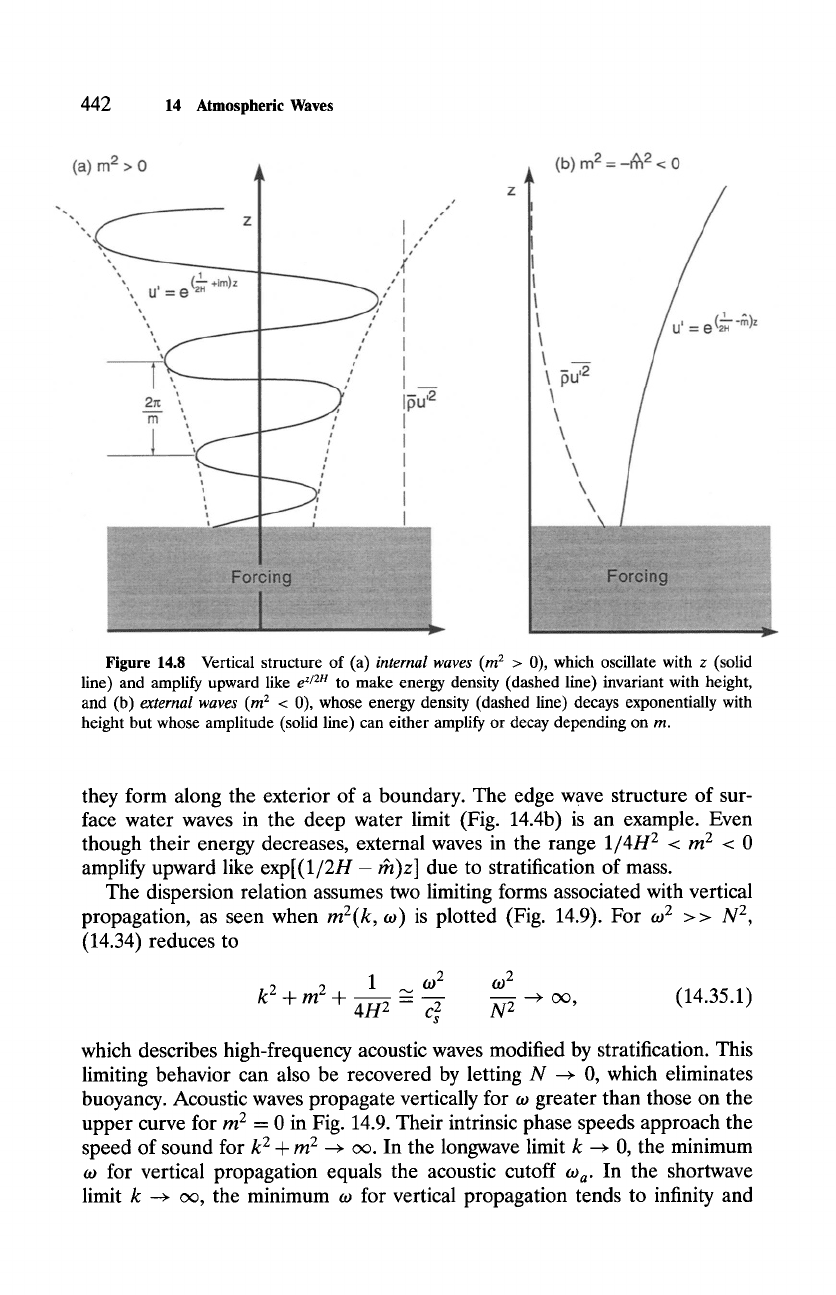
442
14
Atmospheric Waves
(a) m 2 > 0
~ Z I s tits
,(
e ~
IFu '2
i
(b) m 2 =-rrAI 2 < 0
\\
\\
\\
u' = e (~~)z
!i~i!iiiii~ii~iiiiiiiii~iii!!iiii~iiii~iii~!~iiiiiiiiiiii~!i~!iii~iiiii~ii~ii~i!~i!iiiii~i~i!!!iiiii!~!~ii~ii!~!iiii~!~ii!!i~i!~i~i~ii~ii~i~!!~!~i!~i~!~i~i~i!~ii~!i!i~iii~
Figure 14.8 Vertical structure of (a)
internal
waves
(m 2 > 0),
which oscillate with z (solid
line) and amplify upward like
e z/EH
to
make energy density (dashed line) invariant with height,
and (b)
external
waves
(m E
< 0),
whose energy density (dashed line) decays exponentially with
height but whose amplitude (solid line) can either amplify or decay depending on m.
they form along the exterior of a boundary. The edge wave structure of sur-
face water waves in the deep water limit (Fig. 14.4b) is an example. Even
though their energy decreases, external waves in the range 1/4H 2 < m 2 < 0
amplify upward like exp[(1/2H- rh)z] due to stratification of mass.
The dispersion relation assumes two limiting forms associated with vertical
propagation, as seen when
m2(k, to)
is plotted (Fig. 14.9). For w2 >> N 2,
(14.34) reduces to
1
00 2 0) 2
k 2 + m 2 -q '~ --+ oo, (14.35.1)
4H 2 - Cs 2 N 2
which describes high-frequency acoustic waves modified by stratification. This
limiting behavior can also be recovered by letting N ~ 0, which eliminates
buoyancy. Acoustic waves propagate vertically for w greater than those on the
upper curve for m 2 = 0 in Fig. 14.9. Their intrinsic phase speeds approach the
speed of sound for
k 2 -+-m 2 --+
oo. In the longwave limit k ~ O, the minimum
to for vertical propagation equals the acoustic cutoff to a. In the shortwave
limit k ~ c~, the minimum to for vertical propagation tends to infinity and
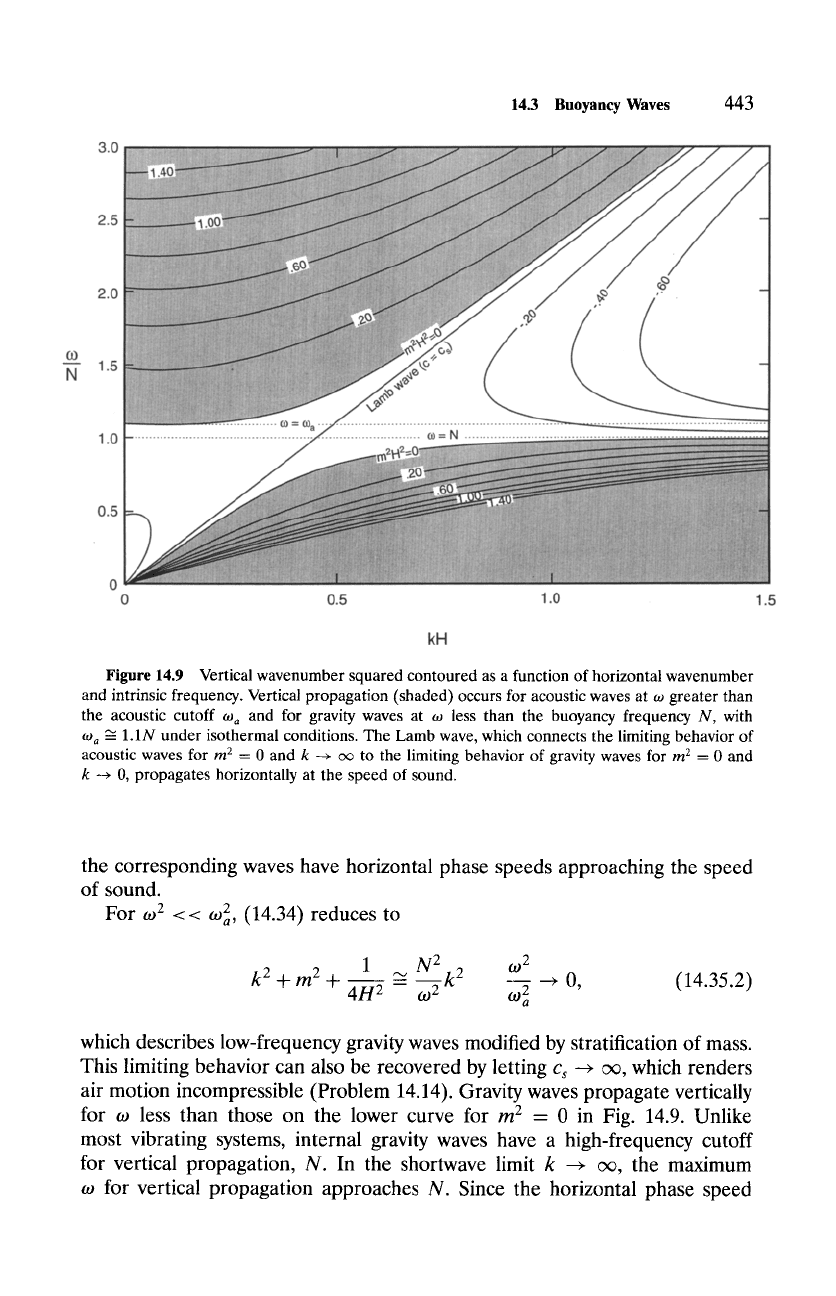
14.3 Buoyancy Waves
443
3.0
2.5
2.0
0)
~
1.5
N
1.0
0.5
m=N
0 0.5 1.0 1.5
kH
Figure 14.9 Vertical wavenumber squared contoured as a function of horizontal wavenumber
and intrinsic frequency. Vertical propagation (shaded) occurs for acoustic waves at w greater than
the acoustic cutoff o.i a and for gravity waves at oJ less than the buoyancy frequency N, with
O) a ~
1.1N under isothermal conditions. The Lamb wave, which connects the limiting behavior of
acoustic waves for m 2 = 0 and k --+ c~ to the limiting behavior of gravity waves for m 2 = 0 and
k ~ 0, propagates horizontally at the speed of sound.
the corresponding waves have horizontal phase speeds approaching the speed
of sound.
2 (14.34) reduces to
For
0) 2 << 0)a,
1
N 2
0) 2
k 2 ~ -~ 0, (14.35.2)
k 2 -k-m 2 -~ 4H 2 -- 60 2 0)2
which describes low-frequency gravity waves modified by stratification of mass.
This limiting behavior can also be recovered by letting
Cs ~ ~,
which renders
air motion incompressible (Problem 14.14). Gravity waves propagate vertically
for w less than those on the lower curve for m 2 = 0 in Fig. 14.9. Unlike
most vibrating systems, internal gravity waves have a high-frequency cutoff
for vertical propagation, N. In the shortwave limit k --+ ~, the maximum
~o for vertical propagation approaches N. Since the horizontal phase speed
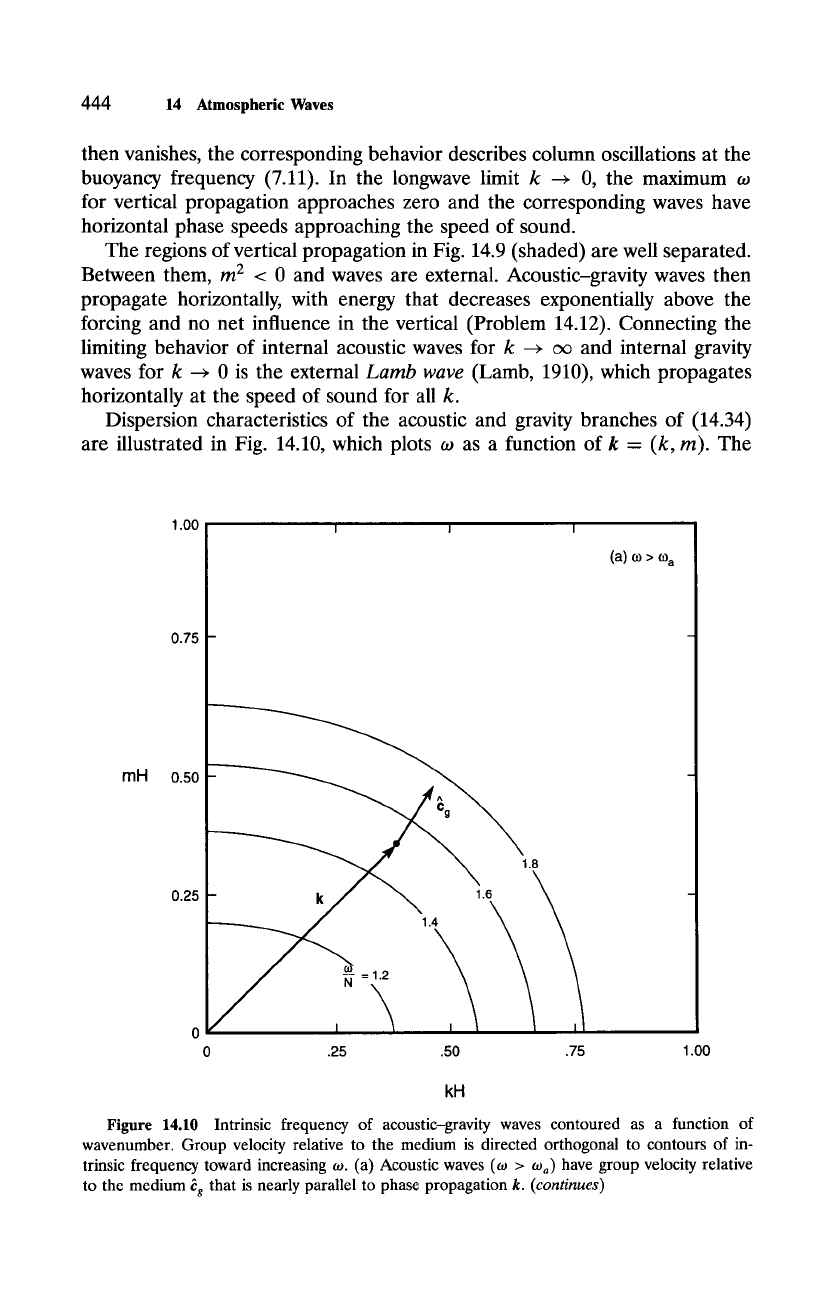
444
14 Atmospheric Waves
then vanishes, the corresponding behavior describes column oscillations at the
buoyancy frequency (7.11). In the longwave limit k ~ 0, the maximum to
for vertical propagation approaches zero and the corresponding waves have
horizontal phase speeds approaching the speed of sound.
The regions of vertical propagation in Fig. 14.9 (shaded) are well separated.
Between them,
m 2 <
0 and waves are external. Acoustic-gravity waves then
propagate horizontally, with energy that decreases exponentially above the
forcing and no net influence in the vertical (Problem 14.12). Connecting the
limiting behavior of internal acoustic waves for k ~ ~ and internal gravity
waves for k ~ 0 is the external
Lamb wave
(Lamb, 1910), which propagates
horizontally at the speed of sound for all k.
Dispersion characteristics of the acoustic and gravity branches of (14.34)
are illustrated in Fig. 14.10, which plots to as a function of k = (k, m). The
1.00
0.75
mH 0.50
0.25
0 .25 .50 .75
(a) co
>
O) a
1.00
kH
Figure 14.10 Intrinsic frequency of acoustic-gravity waves contoured as a function of
wavenumber. Group velocity relative to the medium is directed orthogonal to contours of in-
trinsic frequency toward increasing to. (a) Acoustic waves (to > toa) have group velocity relative
to the medium s that is nearly parallel to phase propagation
k. (continues)
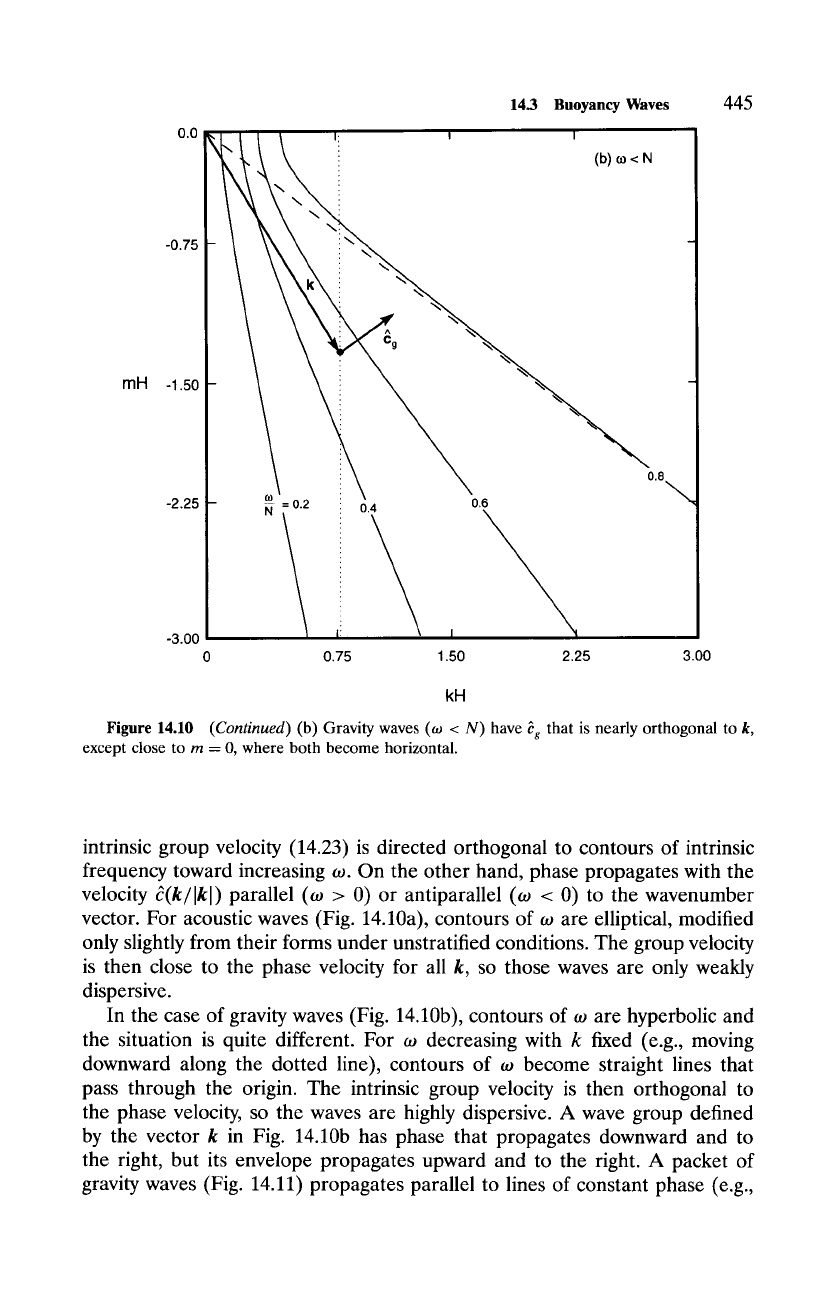
14.3
Buoyancy Waves
445
o.o
-0.75
mH -1.5o
-2.25
-3.00
\ I: I I
k :: ":
. ,~
: 08
oX \
= 0.2
0.4
O.S
",,,,
I: I
0.75 1.50
2.25 3.00
kH
Figure 14.10
(Continued)
(b) Gravity waves (o~ < N) have s
except close to m = 0, where both become horizontal.
that is nearly orthogonal to k,
intrinsic group velocity (14.23) is directed orthogonal to contours of intrinsic
frequency toward increasing ~o. On the other hand, phase propagates with the
velocity
~(k/rk])
parallel (~o > 0) or antiparallel (~o < 0) to the wavenumber
vector. For acoustic waves (Fig. 14.10a), contours of ~o are elliptical, modified
only slightly from their forms under unstratified conditions. The group velocity
is then close to the phase velocity for all k, so those waves are only weakly
dispersive.
In the case of gravity waves (Fig. 14.10b), contours of ~o are hyperbolic and
the situation is quite different. For ~o decreasing with k fixed (e.g., moving
downward along the dotted line), contours of ~o become straight lines that
pass through the origin. The intrinsic group velocity is then orthogonal to
the phase velocity, so the waves are highly dispersive. A wave group defined
by the vector k in Fig. 14.10b has phase that propagates downward and to
the right, but its envelope propagates upward and to the right. A packet of
gravity waves (Fig. 14.11) propagates parallel to lines of constant phase (e.g.,
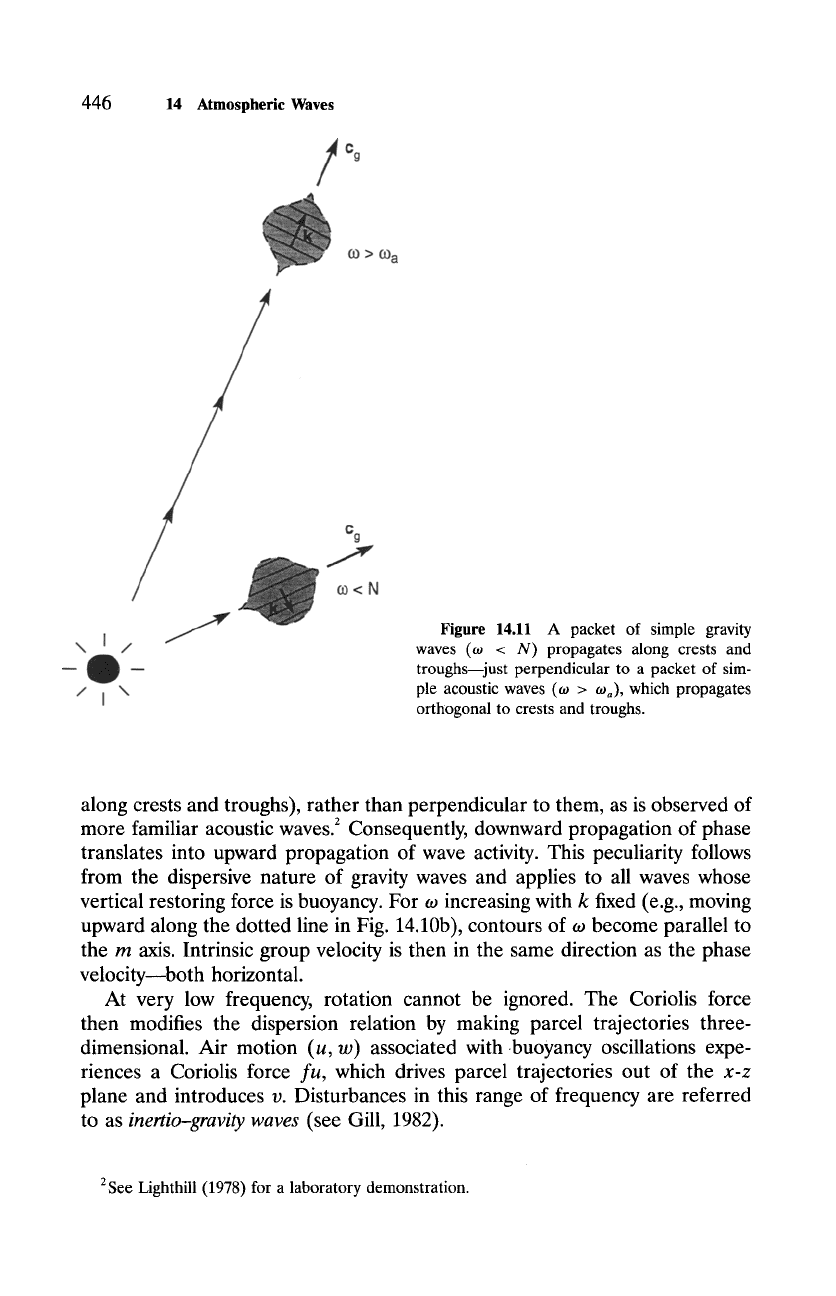
446 14
Atmospheric Waves
Cg
CO> O) a
Cg
7
m<N
\ I /
/ i \
7
I
Figure
14.11 A packet of simple gravity
waves (to < N) propagates along crests and
troughs--just perpendicular to a packet of sim-
ple acoustic waves (to > to a), which propagates
orthogonal to crests and troughs.
along crests and troughs), rather than perpendicular to them, as is observed of
more familiar acoustic waves. 2 Consequently, downward propagation of phase
translates into upward propagation of wave activity. This peculiarity follows
from the dispersive nature of gravity waves and applies to all waves whose
vertical restoring force is buoyancy. For to increasing with k fixed (e.g., moving
upward along the dotted line in Fig. 14.10b), contours of to become parallel to
the m axis. Intrinsic group velocity is then in the same direction as the phase
velocity~both horizontal.
At very low frequency, rotation cannot be ignored. The Coriolis force
then modifies the dispersion relation by making parcel trajectories three-
dimensional. Air motion (u, w) associated with ,buoyancy oscillations expe-
riences a Coriolis force
fu,
which drives parcel trajectories out of the
x-z
plane and introduces v. Disturbances in this range of frequency are referred
to as
inertio-gravity waves
(see Gill, 1982).
2See Lighthill (1978) for a laboratory demonstration.
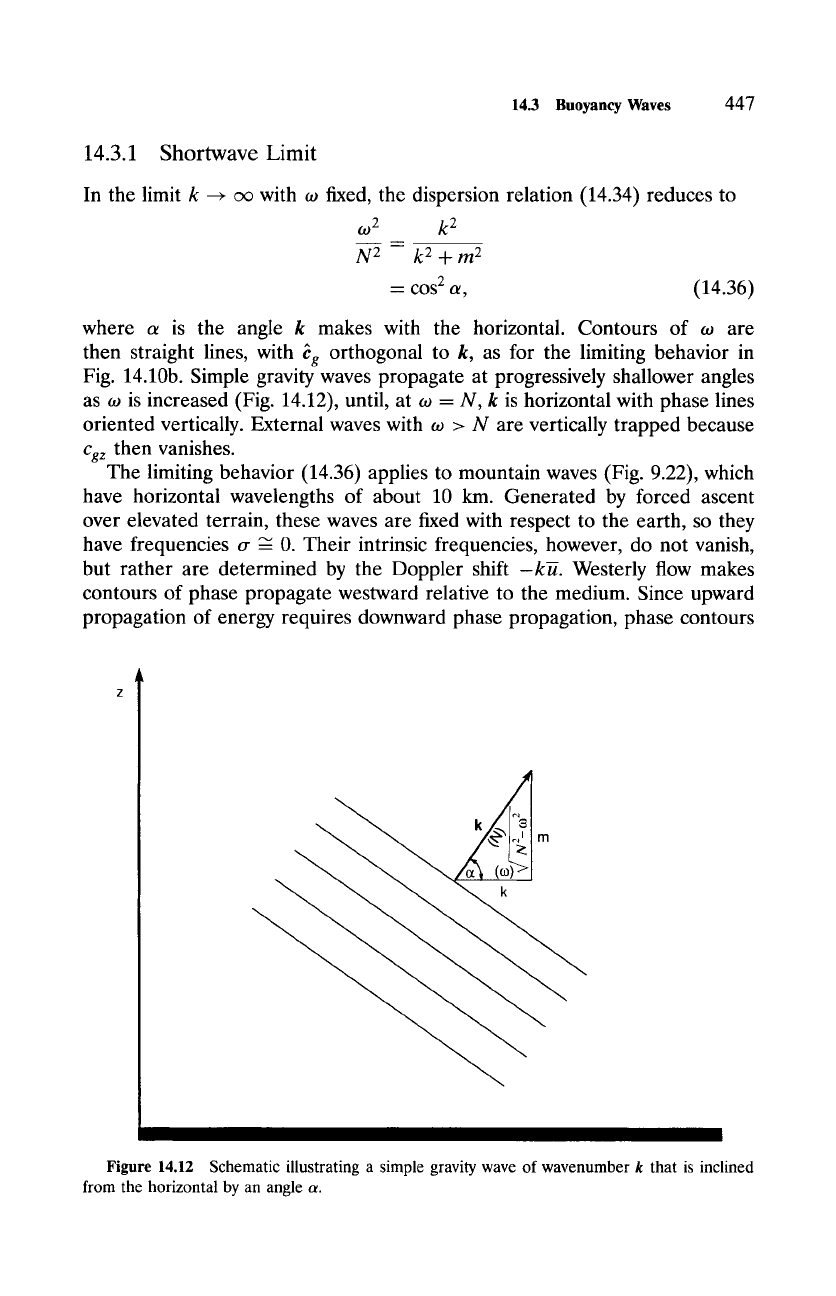
14.3
Buoyancy Waves
447
14.3.1 Shortwave Limit
In the limit k ~ c~ with to fixed, the dispersion relation (14.34) reduces to
to 2 k 2
N 2 k 2 + m 2
= cos: a, (14.36)
where c~ is the angle k makes with the horizontal. Contours of to are
then straight lines, with s orthogonal to k, as for the limiting behavior in
Fig. 14.10b. Simple gravity waves propagate at progressively shallower angles
as to is increased (Fig. 14.12), until, at to - N, k is horizontal with phase lines
oriented vertically. External waves with ~o > N are vertically trapped because
Cg~ then vanishes.
The limiting behavior (14.36) applies to mountain waves (Fig. 9.22), which
have horizontal wavelengths of about 10 km. Generated by forced ascent
over elevated terrain, these waves are fixed with respect to the earth, so they
have frequencies tr ~ 0. Their intrinsic frequencies, however, do not vanish,
but rather are determined by the Doppler shift -k~. Westerly flow makes
contours of phase propagate westward relative to the medium. Since upward
propagation of energy requires downward phase propagation, phase contours
k rn
Figure 14.12 Schematic illustrating a simple gravity wave of wavenumber k that is inclined
from the horizontal by an angle a.
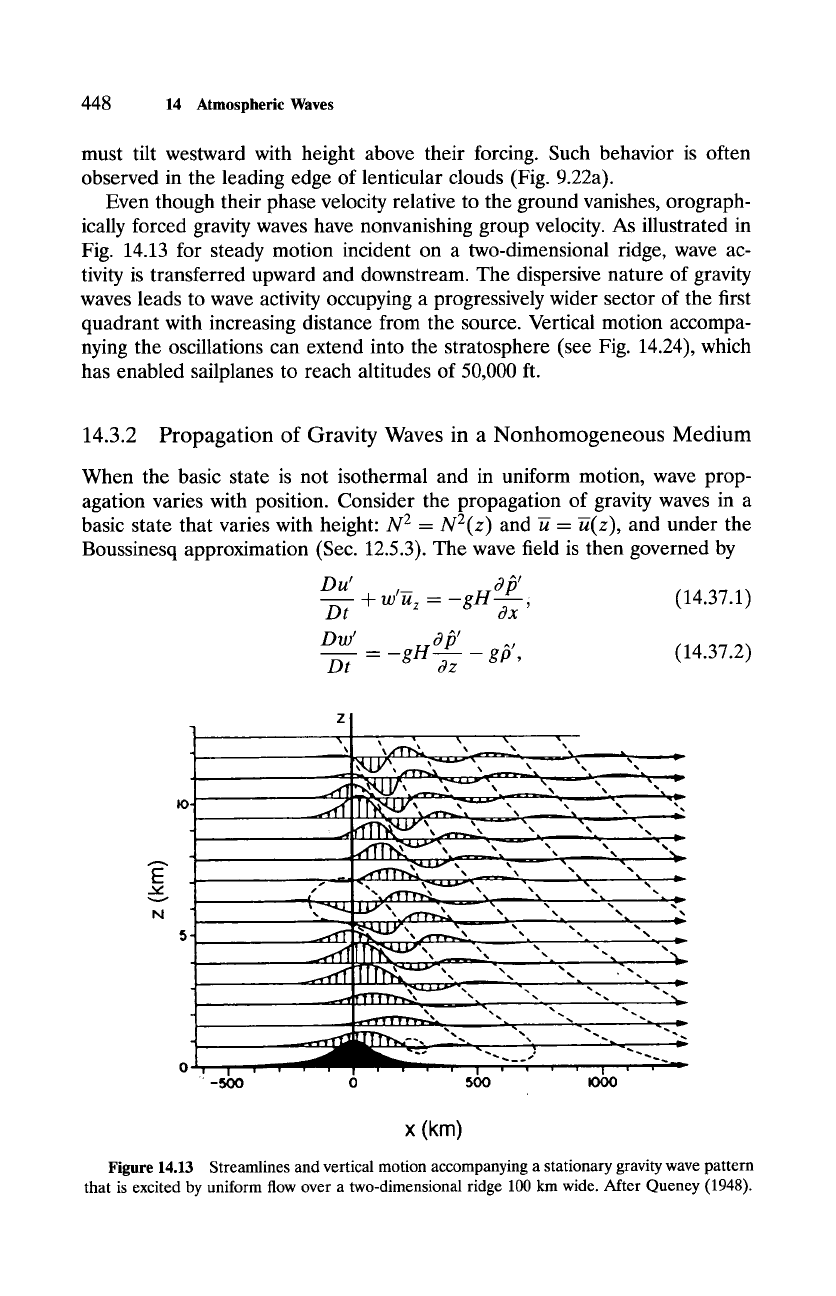
448
14
Atmospheric Waves
must tilt westward with height above their forcing. Such behavior is often
observed in the leading edge of lenticular clouds (Fig. 9.22a).
Even though their phase velocity relative to the ground vanishes, orograph-
ically forced gravity waves have nonvanishing group velocity. As illustrated in
Fig. 14.13 for steady motion incident on a two-dimensional ridge, wave ac-
tivity is transferred upward and downstream. The dispersive nature of gravity
waves leads to wave activity occupying a progressively wider sector of the first
quadrant with increasing distance from the source. Vertical motion accompa-
nying the oscillations can extend into the stratosphere (see Fig. 14.24), which
has enabled sailplanes to reach altitudes of 50,000 ft.
14.3.2 Propagation of Gravity Waves in a Nonhomogeneous Medium
When the basic state is not isothermal and in uniform motion, wave prop-
agation varies with position. Consider the propagation of gravity waves in a
basic state that varies with height:
N 2 -- N2(z)
and K- K(z), and under the
Boussinesq approximation (Sec. 12.5.3). The wave field is then governed by
Du' Off (14.37.1)
D---t
-F
w'-U z
=
- g H
O x '
Dw' -gH Off
Dt
= -~z
gP" (14.37.2)
E
v
N
z
--''" ~ I I P ~~ = \~---,------J ~ 9 v
T 1%~x4J V"~ -7 '''~'~, ", - ", '~
; ~/' I I II ~ . 9 . ~i.'r i Ii ",%
~TT'~",..~ ~ ",~ -~ ", -,, ,,
.'('l I I l'~i, ~ 9 ~ -- ~, ~-~
.,.. ~Tvr'r~ ,, _...._~x ,~ 9
-~ ~ ~.,,rrrv~ ", %,_ ". -
-,,- -, -..
~.rfT1 ! I I ! ! i Pk %. -- %. "~ " "~ --
2 "-,., --,,. --...;
0
-500 0 500 I000
x (km)
Figure 14.13 Streamlines and vertical motion accompanying a stationary gravity wave pattern
that is excited by uniform flow over a two-dimensional ridge 100 km wide. After Queney (1948).
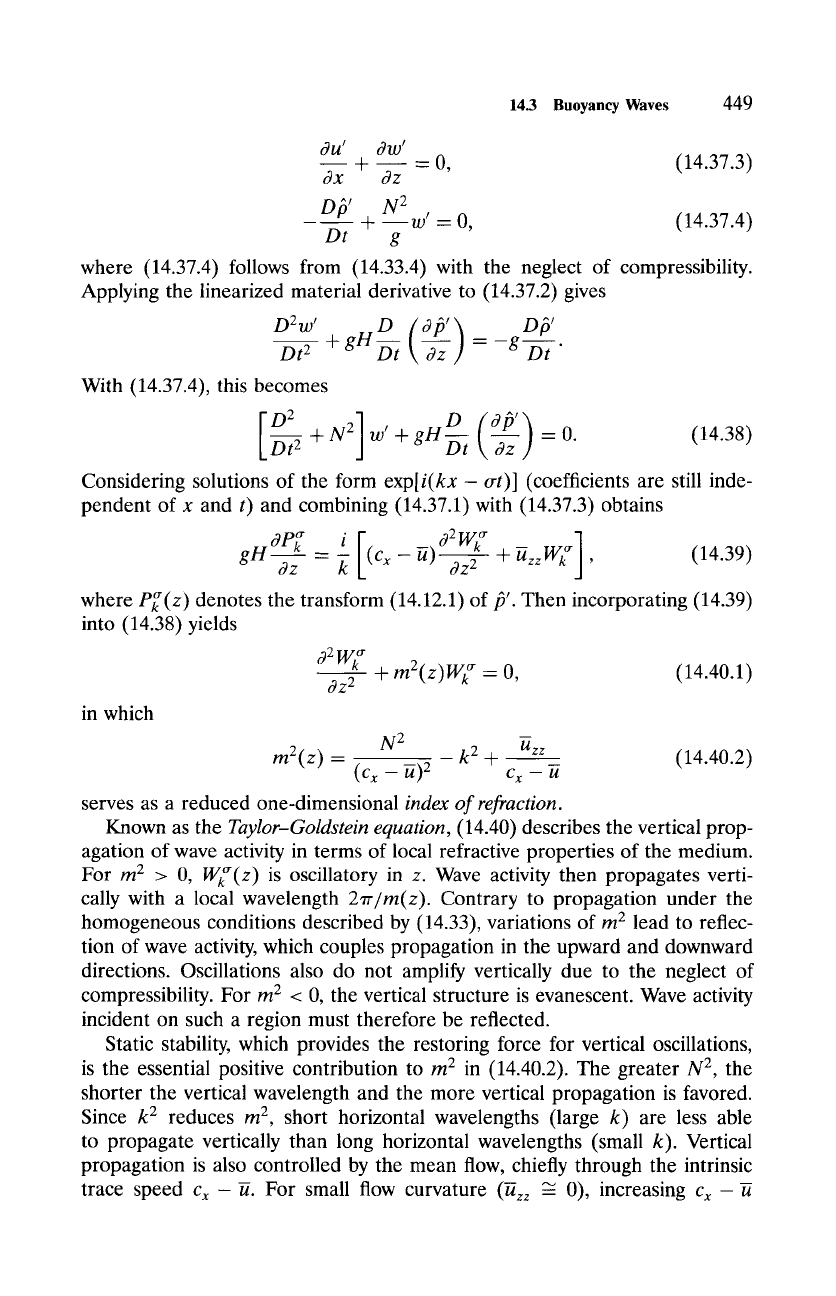
14.3
Buoyancy Waves
449
3U I OW t
+ ~ - O, (14.37.3)
3x 3z
D/~' N 2
-~ + ~w'- 0, (14.37.4)
Dt g
where (14.37.4) follows from (14.33.4) with the neglect of compressibility.
Applying the linearized material derivative to (14.37.2) gives
D2m ' D ( 3~' ) D[~'
D t ----5- + g H-~ -~z -- - g D---t-
With (14.37.4), this becomes
-O~ + N 2 w'
+ g H -~ O z I
Considering solutions of the form
exp[i(kx -
~rt)] (coefficients are still inde-
pendent of x and t) and combining (14.37.1) with (14.37.3) obtains
gH3P~ i[
32w~r
]
og Z = -s ( C x -- -U ) o9Z2 +
-~ z z W~
, (14.39)
where
P~(z)
denotes the transform (14.12.1) of/3'. Then incorporating (14.39)
into (14.38) yields
32Wk r
o3Z 2
+ mZ(z)W~ - O,
(14.40.1)
in which
N 2
m2(z) - - k 2 -4-
Uz~z
(14.40.2)
(C x _
~)2
Cx _ -~
serves as a reduced one-dimensional
index of refraction.
Known as the
Taylor-Goldstein equation,
(14.40) describes the vertical prop-
agation of wave activity in terms of local refractive properties of the medium.
For m 2 > 0,
Wff(z)
is oscillatory in z. Wave activity then propagates verti-
cally with a local wavelength
2~r/m(z).
Contrary to propagation under the
homogeneous conditions described by (14.33), variations of m 2 lead to reflec-
tion of wave activity, which couples propagation in the upward and downward
directions. Oscillations also do not amplify vertically due to the neglect of
compressibility. For m 2 < 0, the vertical structure is evanescent. Wave activity
incident on such a region must therefore be reflected.
Static stability, which provides the restoring force for vertical oscillations,
is the essential positive contribution to m 2 in (14.40.2). The greater N 2, the
shorter the vertical wavelength and the more vertical propagation is favored.
Since k 2 reduces m 2, short horizontal wavelengths (large k) are less able
to propagate vertically than long horizontal wavelengths (small k). Vertical
propagation is also controlled by the mean flow, chiefly through the intrinsic
trace speed
c x --~.
For small flow curvature (K~ ~ 0), increasing
Cx--~
